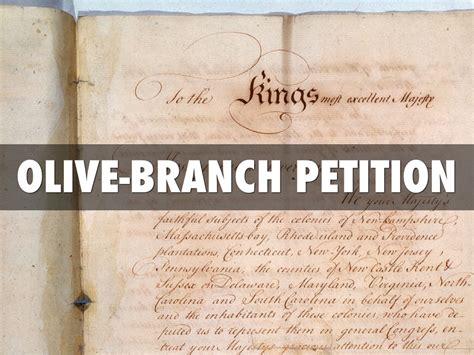In the annals of American history, the Olive Branch Petition stands as a pivotal document that encapsulated the hopes and frustrations of the thirteen colonies on the eve of the American Revolution. The petition, drafted by John Dickinson and adopted by the Continental Congress in July 1775, represented the colonists’ final attempt to reconcile with Great Britain and avert the looming conflict.

Background: The Roots of Colonial Discontent
The Olive Branch Petition emerged amidst a growing tide of resentment and frustration among the American colonists. The British government had imposed a series of economic and political measures that encroached upon the colonists’ rights and liberties. These included the Sugar Act (1764), the Stamp Act (1765), the Townshend Acts (1767), and the Coercive Acts (1774). The colonists perceived these measures as an assault on their autonomy and a violation of their constitutional principles.
The Drafting and Adoption of the Petition
In response to the escalating tensions, the Continental Congress, a gathering of delegates from the thirteen colonies, convened in Philadelphia in September 1774. John Dickinson, a moderate and respected figure, took the lead in drafting a petition to King George III. The petition was adopted by the Congress on July 5, 1775.
The Olive Branch Petition: A Summary
The Olive Branch Petition was a formal and respectful plea to the British monarch. It acknowledged the colonists’ loyalty to the Crown but expressed their grievances and concerns. The petition specifically addressed the following points:
- The colonists had always been loyal subjects of the British Empire.
- The recent British policies had infringed upon the colonists’ rights and liberties.
- The colonists desired a peaceful resolution to the conflict and were willing to negotiate a compromise.
- The petition appealed to the King’s sense of justice and compassion to restore harmony between the colonies and Great Britain.
The British Response: Rejection and Escalation
Despite the measured tone and conciliatory language of the Olive Branch Petition, it was met with a resounding rejection by the British government. King George III dismissed it as “indecent” and refused to consider it. The British government continued to view the colonists as rebellious subjects and escalated its military presence in the colonies.
The Historical Significance of the Olive Branch Petition
The failure of the Olive Branch Petition marked a watershed moment in Anglo-American relations. It shattered the last vestiges of hope for a peaceful reconciliation and pushed the colonies further towards the brink of armed conflict. The petition’s significance lies in the following ways:
- It demonstrated the colonists’ willingness to seek a compromise and avoid war.
- It exposed the intransigence of the British government and its unwillingness to address the colonies’ concerns.
- It served as a catalyst for the escalating hostilities that culminated in the American Revolution.
Conclusion
The Olive Branch Petition stands as a poignant reminder of the efforts made to prevent the American Revolution. Though ultimately unsuccessful, it remains a testament to the colonists’ desire for peace and their determination to preserve their rights. The petition’s legacy serves as a cautionary tale about the dangers of ignoring legitimate grievances and the destructive consequences of escalating conflict.
